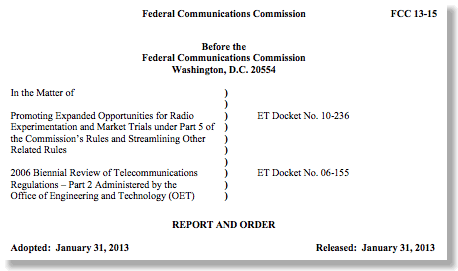Experimental License Rulemaking: It Was Supposed to Help Innovation But One Glitch is a Step Backwards!
The above Report and Order was adopted with great fanfare on January 31. Indeed the fact that the adoption date and release date is the same is an indication of its priority. Its goals and hopes are stated in the following introductory words:
By its actions today, the Commission revises and streamlines its rules to modernize the Experimental Radio Service (ERS). The rules adopted in this Report and Order will update the ERS to a more flexible framework to keep pace with the speed of modern technological change while continuing to provide an environment where creativity can thrive.
The FCC press release kvells even more:
Today’s Report and Order (R&O) expands upon and complements the existing ERS structure, in which the Commission issues individual licenses for each experiment. The new licenses will provide innovators greater flexibility in how they conduct research and development by permitting them to modify existing experiments and conduct new experiments within a broad range of frequencies, emissions, and power levels at defined geographic locations under a single license.
Support was bipartisan as Comm. Pai wrote in a statement:
For a variety of reasons including OMB review of information requirements, the R&O was not published in the Federal Register until April 29th. (78 F.R. 25138) A review of the text a few days ago by your blogger revealed a big surprise not mentioned in the glowing public statements: a key detail is actually a step backwards!Today’s item improves the existing experimental license process. It consolidates all the rules that experimenters must follow into one location: Part 5 of our rules. It also creates new opportunities for innovators to more easily conduct experiments that may lead to the next technological success. Overall, I believe that this order will encourage wireless research and development, and I am therefore pleased to support it.
Compare the long standing text of § 5.85(a) with the revised version in the R&O:
CURRENT VERSION
§ 5.85 Frequencies and policy governing their assignment.
(a) Stations operating in the Experimental Radio Service may be authorized to use any government or non-government frequency designated in the Table of Frequency Allocations set forth in part 2 of this chapter, provided that the need for the frequency requested is fully justified by the applicant.
REVISED VERSION
§ 5.85 Frequencies and policy governing their assignment.
(a) Stations operating in the Experimental Radio Service may be authorized to use any Federal or non- Federal frequency designated in the Table of Frequency Allocations set forth in part 2 of this chapter, provided that the need for the frequency requested is fully justified by the applicant, except that experimental stations may not use any frequency or frequency band exclusively allocated to the passive services (including the radio astronomy service). Stations authorized under subparts E and F are subject to additional restrictions.
Suddenly the phrase “ except that experimental stations may not use any frequency or frequency band exclusively allocated to the passive services (including the radio astronomy service)” was added to the description of what frequencies can be used. While this was in the draft rules in the NPRM, it was never discussed in the NPRM text and no reason was given for the change. Even stranger in the R&O it is discussed in para. 56 in the context of the new “program licenses”, but never discussed as a general requirement for any experimental license. Was the inclusion of the new words in § 5.85(a) simply a drafting error?
Does it matter?
For many passive bands it doesn’t. But the recent TAC meeting made clear that there is a strong FCC interest in “spectrum frontiers” at the edge of spectrum now used. Present FCC rules provide for use up to 95 GHz and implicitly forbid use above there except for experimental licenses. The recent DARPA 100G Broad Area Announcement shows that DARPA is about to spend a lot of money to develop practical millimeter wave wireless systems with capacity greater than 100Gb/s in support of military requirements and this technology is likely to spill over to civil use in areas such as mobile broadband backbone.
The US Table of Allocations provides generously for passive only allocations above 60 GHz. The problem is not the existence of these passive only allocations which have real benefits, rather initial experiments with new technology become much more complex and expensive if they have to totally avoid an emission in a passive band even if there is no passive receiver in the area that might be impacted or if the atmospheric absorption at millimeter wave frequencies really prevents the experimental signal from reaching any passive receiver.
As the date for a possible appeal of the R&O was closing quickly, using his best “jail house lawyer“ skills your blogger filed a Petition for Reconsideration this week. The petition elaborates on the above points. While even under the best of circumstances FCC will not request comment on it soon, reader are welcome to review it and comment to FCC (Docket 10-236) if they wish.
Link to FCC comment filing site
vox populi vox dei
UPDATE

The Commission’s longstanding case-by-case review process for conventional experimental licenses has provided flexibility and spectrum access to experimental programs while ensuring that the needs of co-channel users, including those in the passive bands, are adequately protected. The rule change adopted in the instant Order reverses this successful policy, putting at risk important experimental programs with little corresponding increase in interference protection for passive operations. The rule change is also procedurally deficient because it fails to provide adequate notice or a reasoned explanation to support the Commission’s reversal of policy. For these reasons, Boeing strongly urges the Commission to reconsider this change.
Boeing went beyond the MSS petition and pointed out
(T)he Commission’s records show that OET regularly grants applications for licenses and STAs in restricted bands, including the exclusive allocation passive bands identified in footnote US246. Boeing itself has sought and received experimental authority in these bands as recently as July 2013. Numerous other applicants have also received experimental licenses or STAs in these bands, including Honda Aircraft Company, LLC, the Battelle Memorial Institute, and Raytheon Missile Systems.
No evidence exists in the record of this proceeding or elsewhere that these or similar operations have caused interference to passive services. This is not surprising, given the sophistication of the parties undertaking these experiments and the extensive array of interference mitigation measures available to ensure that operations in passive spectrum do not result in interference to other users.




![Validate my RSS feed [Valid RSS]](valid-rss-rogers.png)

